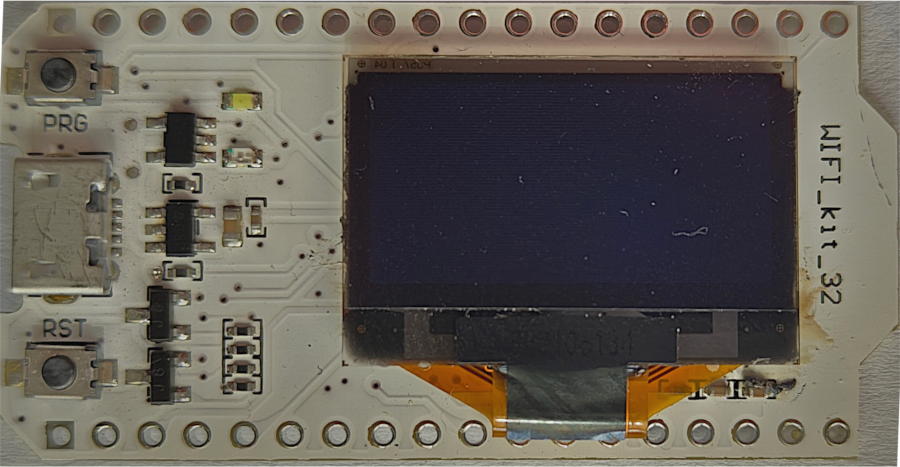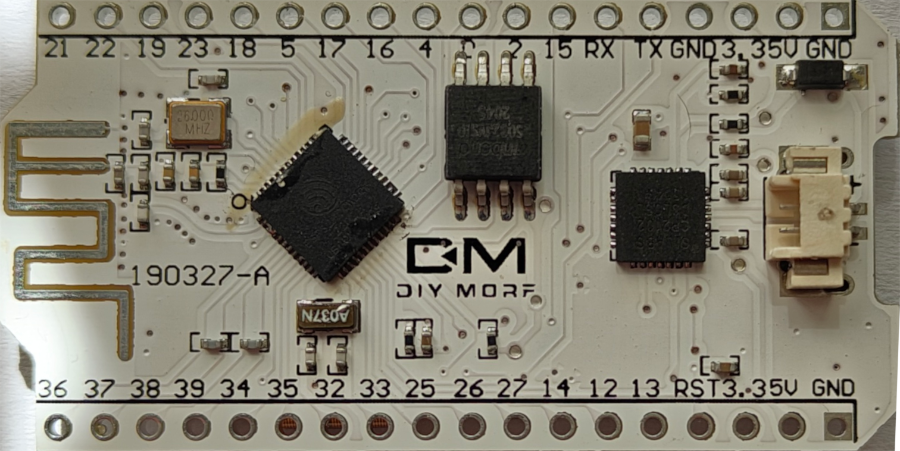In this article, I want to follow up on the experiences I have made and the information I have gathered on reading chip information on the ESP32 and present a script for this.
The ESP_WIKI_kit from Heltec is to be used for this Adventure.
I have a couch here with the label DIY More, but that’s of no interest here.
I ordered the board from Aliexpress at some point.


The most important features:
ESP32, Tensilica LX6 dual-core processor
clocked at 240 MHz
520 KB SRAM integrated in the chip, 802.11 b/g/n HT40 Wi-Fi transceiver
Integrated 4 MByte flash
Wi-Fi antenna
blue 0.96-inch OLED display
CP2102-USB-to-Seriell-Chip
UDP with a throughput of 135 Mbit/s
Operating voltage: 3.3 V to 7 V
Operating temperature range: -40 °C to +90 °C
Let’s turn to the actual task and see what we can do with the ESP32.h and which functions are available to us without any major tricks.
#include <Arduino.h>
void setup() {
Serial.begin(115200);
delay(1000);
Serial.println();
// Heap
Serial.println("Data of the Heap");
Serial.print("Heap Size: ");
Serial.print(ESP.getHeapSize() / 1024, DEC); // Output in KB //total heap size
Serial.println(" KB");
Serial.print("Available Heap Size: ");
Serial.print(ESP.getFreeHeap() / 1024, DEC); // Output in KB ////available heap
Serial.println(" KB");
Serial.print("lowest level of free heap since boot: ");
Serial.print(ESP.getMinFreeHeap() / 1024, DEC); // Output in KB
Serial.println(" KB");
Serial.print("largest block of heap that can be allocated at once: ");
Serial.print(ESP.getMaxAllocHeap() / 1024, DEC); // Output in KB
Serial.println(" KB");
Serial.println();
//SPI RAM
Serial.println("Data of the PSRAM");
Serial.print("PSRAM Size: ");
Serial.print(ESP.getPsramSize() / 1024, DEC); // Output in KB
Serial.println(" KB");
Serial.print("Free PSRAM Size: ");
Serial.print(ESP.getFreePsram() / 1024, DEC); // Output in KB
Serial.println(" KB");
Serial.print("Min_Free PSRAM Size: ");
Serial.print(ESP.getMinFreePsram() / 1024, DEC); // Output in KB
Serial.println(" KB");
Serial.print("Free PSRAM Size: ");
Serial.print(ESP.getMaxAllocPsram() / 1024, DEC); // Output in KB
Serial.println(" KB");
Serial.println();
Serial.println("chip data");
//Chip
Serial.print("Chip Revision: ");
Serial.println(ESP.getChipRevision());
Serial.print("Chip Model: ");
Serial.println(ESP.getChipModel());
Serial.print("Chip Cores: ");
Serial.println(ESP.getChipCores());
Serial.print("Chip Freq: ");
Serial.print(ESP.getCpuFreqMHz());
Serial.println(" MHz");
Serial.println();
Serial.println("Data of the Flash memory");
//Flash
Serial.print("Flash Size: ");
Serial.print(ESP.getFlashChipSize() / 1024, DEC); // Output in KB
Serial.println(" KB");
Serial.print("Flash Chip speed: ");
Serial.println(ESP.getFlashChipSpeed());
Serial.print("Flash Chip Mode: ");
Serial.println(ESP.getFlashChipMode());
Serial.println();
Serial.println("Data of the sketch");
// Sketch
Serial.print("Sketch Size: ");
Serial.print(ESP.getSketchSize() / 1024, DEC); // Output in KB
Serial.println(" KB");
Serial.print("Sketch Size MD5: ");
Serial.println(ESP.getSketchMD5());
Serial.print("Free sketch Space: ");
Serial.print(ESP.getFreeSketchSpace() / 1024, DEC); // Output in KB
Serial.println(" KB");
Serial.println();
Serial.println("Fuse: ");
uint64_t macAddress = ESP.getEfuseMac();
Serial.print("MAC Address: ");
Serial.print((macAddress >> 40) & 0xFF, HEX); // First Byte
Serial.print(':');
Serial.print((macAddress >> 32) & 0xFF, HEX); // Second Byte
Serial.print(':');
Serial.print((macAddress >> 24) & 0xFF, HEX); // Third Byte
Serial.print(':');
Serial.print((macAddress >> 16) & 0xFF, HEX); // Fourth Byte
Serial.print(':');
Serial.print((macAddress >> 8) & 0xFF, HEX); // Fifth Byte
Serial.print(':');
Serial.println(macAddress & 0xFF, HEX); // Sixth Byte
}
void loop() {
// Do nothing
}
I have already explained the individual functions available in ESP.h in more detail in the article “What’s in my ESP“.
But I would like to explain the last part of the code for determining the MAC address in more detail.
What does this line do, for example? Serial.print((macAddress >> 40) & 0xFF, HEX); // First byte
Bit operations for extracting the bytes
1. macAddress >> 40
- macAddress is a 64-bit number (uint64_t) that represents the MAC address of the ESP32.
- >> 40 is a bitwise right shift operator. This operator shifts the bits of the number 40 positions to the right.
- This shift moves the first byte of the MAC address (the highest 8 bits) to the lowest 8 bit positions of the number. This means that the first byte is now in the position that we can easily extract.
2. & 0xFF
- 0xFF is a hexadecimal constant that corresponds to the binary number 11111111. This is 8 ones in binary representation, which corresponds to 255 in decimal form.
- The bitwise AND operator (&) is used to extract only the last 8 bits of the number. This helps to limit the value to a range from 0 to 255, which corresponds to exactly one byte.
- Without this step, additional bits could remain in the higher position of the number, which are irrelevant for our purposes.
3. Serial.print(…, HEX)
- Serial.print(…, HEX) outputs the resulting number in hexadecimal form.
- The HEX parameter specifies that the output should be in hexadecimal (i.e. base 16) representation.
Composition of the entire line
The line Serial.print((macAddress >> 40) & 0xFF, HEX); works as follows:
Output: The result is output in hexadecimal form.
Right shift: The MAC address is shifted 40 bits to the right so that the first byte of the MAC address occupies the lowest 8 bit positions.
Masking: Bitwise AND with 0xFF means that only the first byte is retained and all other bits are removed.
And now I don’t want to withhold the output of the code shown above from you.
For better orientation and reference to the page with the explanations of the functions, I have linked each section.
rst:0x1 (POWERON_RESET),boot:0x17 (SPI_FAST_FLASH_BOOT)
configsip: 0, SPIWP:0xee
clk_drv:0x00,q_drv:0x00,d_drv:0x00,cs0_drv:0x00,hd_drv:0x00,wp_drv:0x00
mode:DIO, clock div:2
load:0x3fff0030,len:1184
load:0x40078000,len:13232
load:0x40080400,len:3028
entry 0x400805e4
Data of the heap
Heap Size: 367 KB
Available Heap Size: 342 KB
lowest level of free heap since boot: 336 KB
largest block of heap that can be allocated at once: 111 KB
Data of the PSRAM
PSRAM Size: 0 KB
Free PSRAM Size: 0 KB
Min_Free PSRAM Size: 0 KB
Free PSRAM Size: 0 KB
Data of the Chips
Chip Revision: 1
Chip Model: ESP32-D0WDQ6
Chip Cores: 2
Chip Freq: 240 MHz
Flash memory data
Flash Size: 4096 KB
Flash Chip speed: 40000000
Flash Chip Mode: 2
Data of the sketch
Sketch Size: 268 KB
Sketch Size MD5: 0afef9566b4ff39e40d71f2869165042
Free Sketch Space: 1280 Kb
Fuse
MAC Address: B8:A4:C0:7E:B9:94
Here we are again at the end of this DIYTechAdventure. I hope you found the trip just as exciting as I did writing it. And remember – comments are always welcome!
